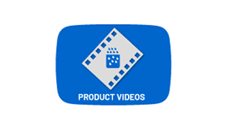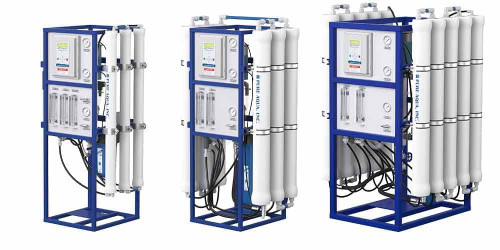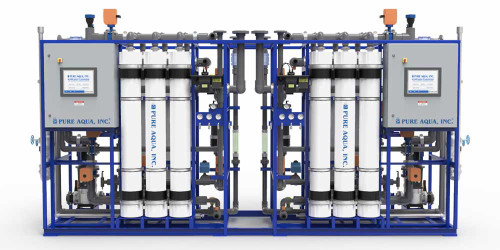NSF Certified Reverse Osmosis RO Systems (Commercial & Industrial):
NSF (National Sanitation Foundation) which is now globally known as NSF International is a leading global provider of public health and safety-based risk management solutions serving the interests of the public, business communities and government agencies. They develop uniform, consensus-based national standards and bring together regulators, industry, consumers and public health experts in the process. They have developed public health and safety American National Standards and protocols for appliances, food equipment, drinking water filters and other products.
A Reverse Osmosis System is composed of a series of filtration equipment, Ion-exchange equipment, chemical and disinfection systems. These RO systems can be used to provide filtered or low TDS water into a process equipment in the industries but in most part they are related to water that will be consumed by humans. When RO filtration is needed to produce water for human drinking, the filtration media, valves, piping and whatever else will be touched by water being filtered should have been tested to be safe and certified by the NSF to be safe for human consumption.
[custom-specifications]
Commercial RO systems have lower flow capacities than Industrial RO systems and most of the time they are equipped with Media Filters and Softener systems as pre-treatment. These tanks should have NSF-approved media, resin and their top-mounted valves (such as Fleck and Clack) should also have NSF-certifications. The PVC pipes that are being used for the water flow, as well as the RO membranes and pressure vessels, should all be NSF-certified as well to make the whole system certified safe to produce drinking water. Industrial RO systems sometimes have different pre-treatment designs and might use chemicals instead of Ion-Exchange resin to address the scaling tendencies of water. Antiscalant chemical systems are sometimes a more cost-effective solution over softeners. These systems should be tested and certified safe by NSF to be used for this application as well.
[/custom-specifications]
[custom-features]
NSF/ANSI Standard 42 covers Point-of-Use and Point-of-Entry systems designed to reduce specific aesthetic or non-health-related contaminants, such as chlorine, taste and odor, and particulates, which may be present in drinking water. Standard 42 is in place to establish minimum requirements for material safety, structural integrity, product literature, and aesthetic, non-health related contaminant reduction performance claims. This standard applies to carbon filtration, as well as other filtration media, such as ceramic filters.
A system may be certified under Standard 42, and other NSF/ANSI Standards for specific contaminant reduction (i.e. chlorine) by meeting the minimum level of reduction required by the Standard. This does not necessarily mean that the system is removing all of the contaminant present in the source water. Several classes are used to define the level of particulate reduction, ranging from Class VI for systems removing coarse particles larger than 50 micrometers, to Class I for drinking water treatment systems that reduce particles as small as 0.5 to 1.0 microns.
NSF/ANSI Standard 53 addresses Point-of-Use and Point-of-Entry systems, mostly carbon filtration, designed to reduce specific health-related contaminants that may be present in drinking water. This standard establishes minimum requirements for material safety, structural integrity, product literature, and health related contaminant reduction performance claims. Some systems fall under the scope of Standard 42 and 53 because they both address aesthetic and health claims. A system is NSF certified under Standard 53 if the filter system reduces a significant amount of harmful contaminants from drinking water. These contaminants may be microbiological, including filterable cysts, chemical, including disinfection byproducts, pesticides, herbicides, and insecticides, or particulate in nature. NSF may certify that a drinking water treatment unit may control one or more health effect contaminants. A products performance data sheet would state whether the system is effective in reducing many pollutants, or just a few.
NSF/ANSI Standard 44 is applicable to ion exchange water softenersdesigned for hardness reduction and health claims.
NSF/ANSI Standard 55 is applicable to systems utilizing ultraviolet disinfection or sterilization light to provide disinfection. Standard 55 establishes minimum requirements for the certification of UV systems.
NSF/ANSI Standard 58 is applicable to systems using reverse osmosis (RO) technology to focus on total dissolved solids (TDS) reduction and health claims.
[/custom-features]
[custom-usage]
Many large companies are currently looking to invest in the water bottling and supply industry. Most of the time, the water these companies use is municipally treated potable water, which is already safe to drink. However, the water bottling and supply companies want to improve the taste or lower the total dissolved solids in the water a bit more to satisfy the customers’ tastes and preferences for bottled or flavored water products. NSF-tested and certified RO system equipment provides assurance that this water will continue to be safe to drink after the filtration process. The permeate water will be free of any contamination brought about by degradation of filtration materials while the equipment is in use.
[/custom-usage]
-
High efficiency
Very neat design and comes with all the components I need for a smooth operation.
- Related Project1:
- https://pureaqua.com/skid-mounted-ro-system-with-nsf-components-for-fish-cannery-20000-gpd-alaska-usa/
- Related Project2:
- https://pureaqua.com/containerized-twin-alternating-greensand-filters-w-nsf-components-for-iron-reduction-60-gpm-usa/
- Related Project3:
- https://pureaqua.com/commercial-seawater-ro-equipment-12000-gpd-singapore/
- Related Project4:
- https://pureaqua.com/commercial-filtration-system-for-metals-reduction-35-gpm-guatemala/
 ENGLISH arrow_drop_down
ENGLISH arrow_drop_down
 ESPAÑOL
ESPAÑOL ???????
??????? PORTUGUÉS
PORTUGUÉS FRANÇAIS
FRANÇAIS














